Introduction
NEVER TAKE SAFETY FOR GRANTED WHEN YOU ARE WORKING WITH PESTICIDES! Think about these questions. Do your mixing practices involve procedures that prevent contaminating your surroundings and your water source? How are your pesticides stored? Is your storage area safe and secure? Are you prepared for an emergency, such as a spill while transporting pesticides, or vandalism to your storage area or equipment? These issues are not specifically addressed on the pesticide label but must be considered. They are regulated by government agencies such as the Environmental Protection Agency and the Nevada Department of Agriculture.
Nevada Department of Agriculture. Pesticide labels are legal documents that provide specific information on the use of the pesticide, personal protective equipment, and environmental precautions. If followed correctly, the label instructions ensure the target pest is controlled with little impact to humans, other species and the environment. Pesticide safety regulations are enforced by government agencies and direct the everyday activities of the commercial pest management industry and farm operations. These regulations mandate safety but don’t necessarily inform you what must be done and how to do it. Safety precaution methods used in order to comply with these regulations are left to the individual so that they may be adapted to various sites and operations.
While using pesticides, there are reliable, practical, simple and cost effective safety procedures that can be followed to help you comply with safety regulations. If used, they ensure your well-being, as well as that of others and non-target species. They also protect the environment.
Preventing Off-Site Movement
Make sure that a pesticide is only applied to the area that needs the pesticide. Do not allow it to contaminate non-target areas through backflow, spills and improper disposal.
A hose left immersed in a tank while filling the tank with pesticides forms a direct waterway between the tank filled with pesticides and the water source. To avoid contamination of the water source:
- Build an air gap. Do not place the hose directly into the pesticide mixture in the spray tank. Leave space between the end of the hose and the mixture so that the pesticides cannot be siphoned back into the water source.
- Install a water tank that is only used to fill application equipment, eliminating the possibility of contaminating a well or public water system.
- Employ timers, floats and backflow devices. Timers and floats automatically shut the water off when the supply tank is full. Backflow devices keep the pesticide mixture from being siphoned into the water supply.
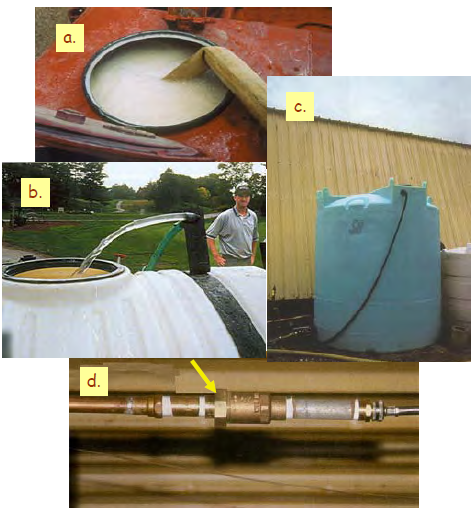
a. Never place a hose directly into the pesticide mixture.
b. A plastic fixture mounted on a sprayer creates an air gapbetween the water supply hose and the tank.
c. Plastic water tank dedicated for use in filling application equipment.
d. Backflow prevention device added to a water line.
Open drains that lead to sewers and septic systems allow spilled pesticide or leaks from containers or equipment to flow directly into the sewer or septic system, ultimately contaminating the environment. To avoid polluting:
- Use removable plugs to temporarily seal floor drains.
- Disconnect sink drains so that the spill flows into a bucket instead of into a sewer. Be sure that the bucket contents are disposed of appropriately, such as being added to the sprayer’s tank for application according to the label.
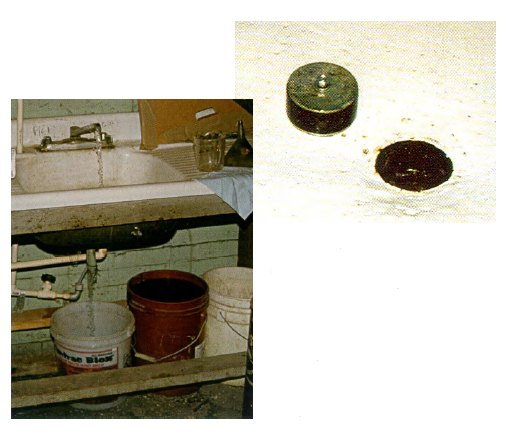
Right: Expansion plug used to seal drain.
Left: The pipe beneath the sink is disconnected to collect the spill in a bucket and the mixture used or disposed of properly.
Pesticide spills can lead to regulatory involvement and costly clean-up expenses. Even small spills over a long period can lead to serious soil and water contamination. To avoid contamination from pesticide spills:
- Use secondary containment devices for all pesticide storage. The containment volume should be greater than the volume of the pesticide storage tank.

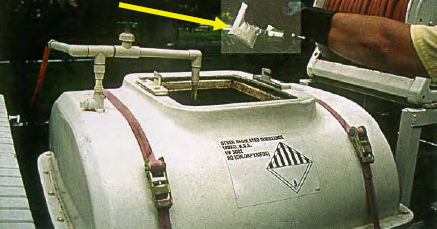
Left: A puncture gun being used to rinse a container. The rinsate is flowing directly into the spray tank.
Right: A water-soluble bag being dropped into a spray tank.
Legally, a plastic pesticide container is not empty until it has been rinsed free of residue. Unrinsed containers are hazardous waste and cannot be legally disposed of in a landfill. The longer a container is left unrinsed, the harder it becomes to clean and the greater the potential for polluting groundwater and property. To prevent contamination from unrinsed or inadequately rinsed pesticide containers:
- Pressure rinse pesticide containers with the water and chemicals flowing directly into the spray tank. If pressure rinsing is not available, triple rinse containers and add the rinsate to the spray tank. These methods have the added benefit of using all of the chemical you paid for!
- Purchase products in containers such as mini-bulks and water-soluble bags, or granular material in plastic jugs. This kind of pesticide packaging may not have to be triple rinsed.
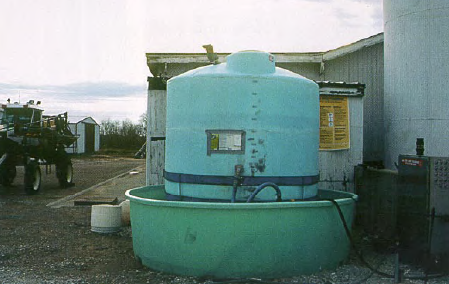
A pesticide tank placed in a containment tray to hold leaks and spills.
Safe and Proper Storage
Safe and proper storage of pesticides and their containers is crucial. Pesticide leaks and spills that are not recovered can enter the air, soil and water. The resulting contamination reduces your property values, triggers enforcement actions, and may be very expensive to clean-up.
Unused and outdated pesticides are a hazard. Improper disposal may cause air, soil and water contamination. To prevent pollution:
- Call the Nevada Department of Agriculture for details about the “free of charge” waste pesticides disposal service they provide.
Reno: 775-688-1182,
Las Vegas: 702-486-4690,
Winnemucca: 775-623-6502
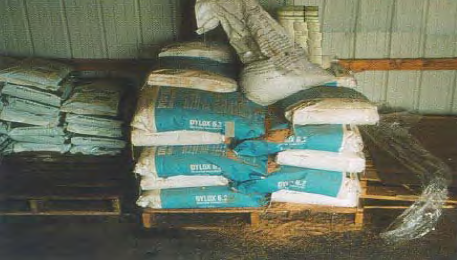
Pesticide packaging can deteriorate and the spilled contents contaminate
air, soil and water, inadvertently exposing employees and others to pesticides.
To avoid leaks and spills of stored pesticides:
- Reclaim your pesticides by using a floor sump or drain that collects spilled pesticides into a holding tank. Use a bucket to collect any drips or leaks from nozzles and other equipment.
- Install a reclamation system that cleans rinse water through a filter system and then reuses the water in pesticide applications.
- Wash pesticide equipment at the job site by using a washer system mounted on your equipment. The rinsate is directed back onto the treated area to avoid carrying residues back to your facilities.
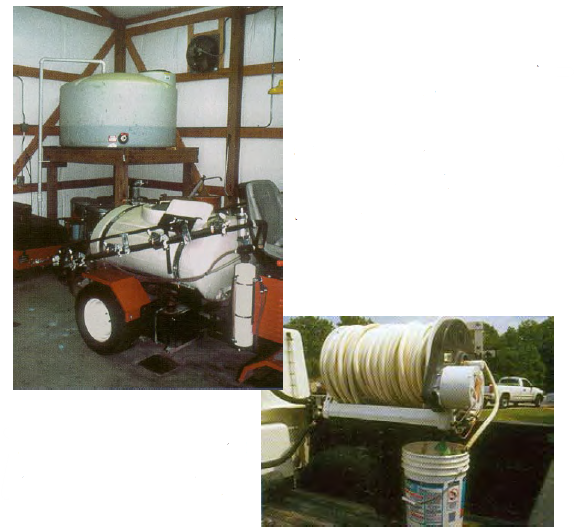
Left: A floor sump collects spilled pesticides which are then transferred to the storage tank in the rear for reuse in a legal pesticide application.
Right: A bucket is used to catch pesticides released from a nozzle.
To avoid contaminating your facilities, use proper storage units:
- Wooden shelving can be sturdier and cheaper than metal, but it can absorb leaking chemicals. Solid metal shelving is a better choice. Any shelving used should be sturdy and properly constructed. When storing pesticides on shelving, secondary containment devices, such as plastic tubs or trays with raised edges, should be used to contain spills and leaks.
- Equipment and pesticides resting on the floor or ground should also be placed in a containment unit such as a barrel, plastic tub or pad.
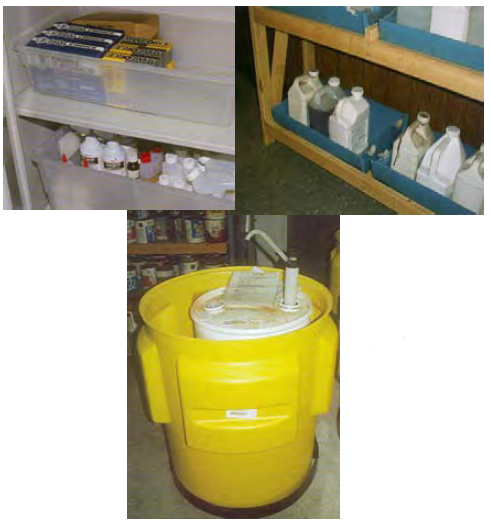
Above: Store pesticides on shelves in containers with raised edges to hold spills.
Below: Use a barrel or tub to contain pesticides stored on the floor or ground.
Small pesticide leaks and drips add up over time. They can produce irritating and harmful odors. Avoid contamination from small spills by:
- Using a common bucket as a simple containment for leaks and drips. Use the collected product in a spray application.
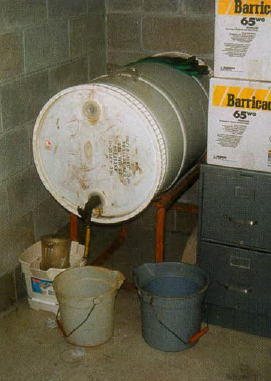
The way you control leaks and drips need not be fancy, just practical and easy to manage.
Keep pesticides in their original container. When a chemical is transferred from its original container, all too often its original label is lost, leaving the identity of the contents in the new container in question. Most hazardous waste facilities will not accept unidentified pesticides, making it very difficult, costly, and hazardous to dispose of them. The risks of trying to use a pesticide whose identity is not clearly known could result in an ineffective or illegal application and possible damage to property and equipment. To avoid troubles caused by unlabeled pesticides:
- Properly identify all pesticides in all containers, including sprayers and tanks. Use plastic laminated labels.
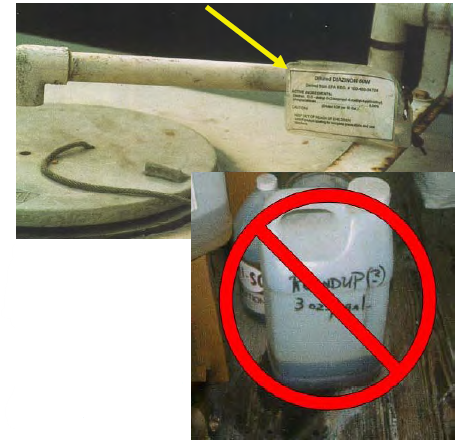
Above: A laminated tag attached to a spray tank.
Below: An example of what not to do.
Do not keep outdated chemicals. Their packaging may deteriorate over time, making the problem of what to do with them more difficult. To manage outdated pesticides:
- Date every pesticide container as it is placed into inventory. Inventory management is necessary to avoid dealing with outdated materials.
- Buy only the quantity of pesticide you plan to use.
- Contact the Nevada Department of Agriculture to inquire about their waste pesticide collection program. Outdated chemicals should be labeled, put in protective containers, if necessary, and locked up until proper disposal can be arranged.
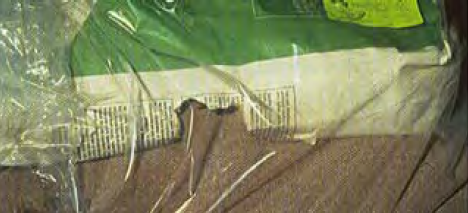
A torn bag of unwanted pesticide placed in a plastic bag awaiting suitable disposal or use according to the label.
Storing pesticides outdoors or in buildings that are not temperature-controlled may expose them to intense heat or freezing temperatures that can leave them unusable. To ensure pesticides are not exposed to extreme temperatures:
- Construct an insulated container or closet and use three light bulbs to keep chemicals from freezing.
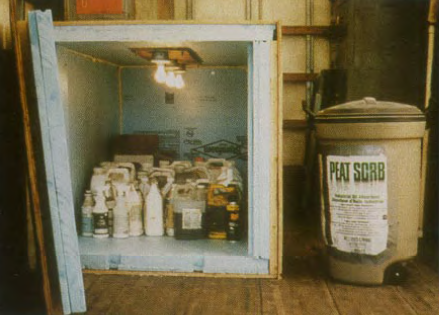
Left: Maintain moderate storage temperatures. An insulated box can reduce extreme
high temperatures in the summer and, with three light bulbs, prevent freezing of products during the winter.
Empty pesticide containers that have been triple rinsed must be properly stored until their disposal. They should not be reused unless the label allows their recycling and a recycling service is available. To prevent rinsed pesticide containers from being taken for reuse:
- Keep them in a locked area or use a locked dumpster or other container.
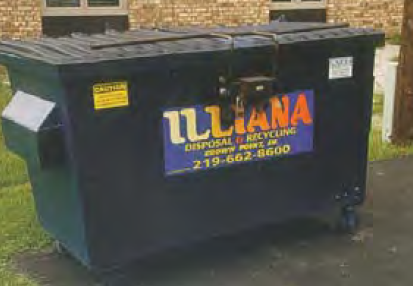
A locking dumpster prevents empty pesticide containers from being taken for reuse.
Preparing for Emergency Situations
Being prepared in advance for emergencies and avoiding them if possible by thinking ahead can save time and money and reduce much liability. Consider these ideas.
Take two simple steps to prepare for an emergency:
- Make sure your insurance coverage is adequate. Work with an insurance agent to make certain your insurance covers all the situations in which you use pesticides — transportation, application, storage, etc. Don’t be afraid to ask questions.
- Train your employees on emergency procedures.
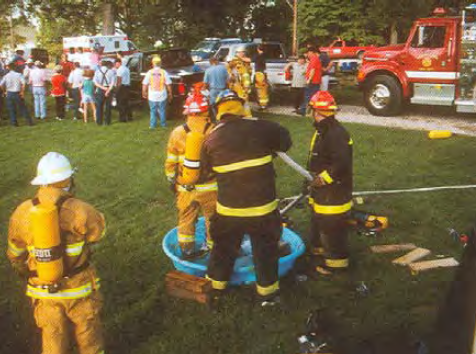
A mock emergency can be used to train employees and local fire departments.
There are risks involved when transporting pesticides. Are the chemicals you are carrying flammable, explosive, corrosive or toxic? What is the potential exposure to the driver, workers and passersby? Is there an environmental risk? Understand the risks and ensure that vehicles used to transport pesticides are equipped for safe transportation and that emergency procedures are in place:
- Securely anchor all pesticide containers by using a box, stabilizer bar, clamps, straps, etc. Install safety mirrors to improve your sight behind and beside your vehicle. Protect hoses from wear and tear with clamps or protective covers. Carry a spill kit at all times.
- Keep chemicals and equipment locked and secured from theft, vandalism and terrorism.
- Carry only the amount of chemicals needed to complete the day’s jobs.
- Display signs on your vehicle to alert the public and emergency responders that you are carrying pesticides.
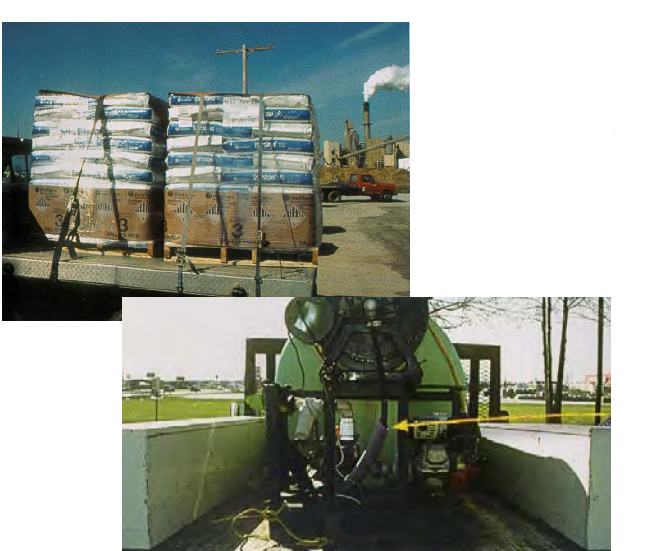
Left: Pesticides securely anchored for transport.
Right: A pressurized spray hose threaded through a larger hose protects it from wear and tear.
To make information and access available to emergency responders:
- Have a designated receptacle that contains emergency information. Whether on your vehicle or at your physical location, make sure definitive information is easily available so that responders can make informed decisions.
- Ensure that your building can be located and easily accessed by emergency responders. Place signage around your building that will help responders locate water shutoff valves, electrical boxes and fire alarms. Make available the names and phone numbers of those who should be contacted in an emergency.
- Work with emergency responders to make a plan as to what actions will be taken if an emergency occurs at your facility.
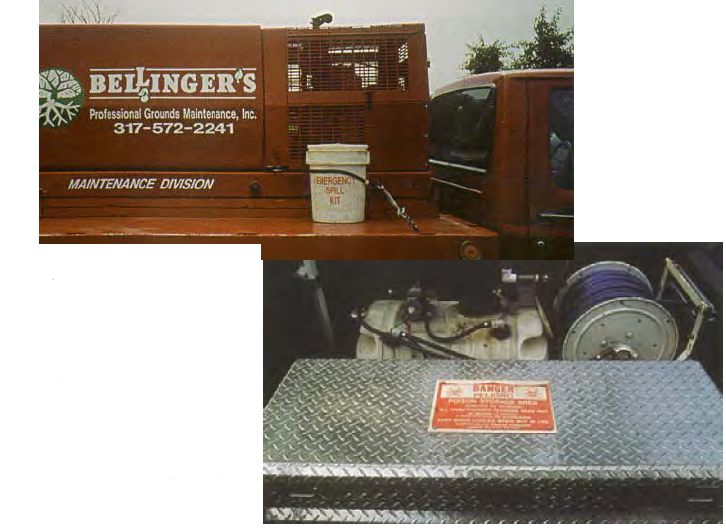
Left: Always carry a spill kit.
Right: Keep chemicals secured. Display signs warning that there are pesticides on board.
Be prepared for an emergency:
- Have supplies and equipment on hand and easily accessible at your facility, job site or in your vehicle.
- Always have plenty of clean water available to thoroughly rinse any splashes or spills that may occur.
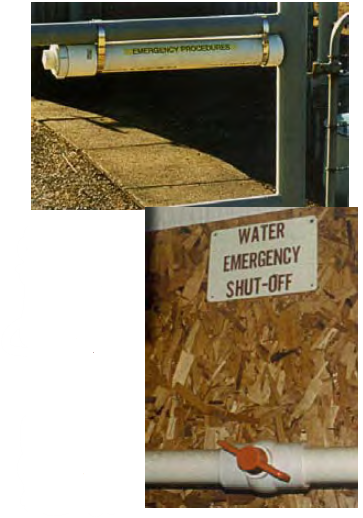
Left: PVC pipe used as storage for emergency information.
Right: Water shut-off valve clearly marked.
Avoid vandalism and the theft of chemicals that may be used for illegal and terrorist activities. Be sure to:
- Secure all locations, equipment and chemicals. Use the security means appropriate for securing storage buildings and equipment such as fences, locks, etc. Use lights at night to make it more difficult for vandals or burglars to enter facilities unseen.
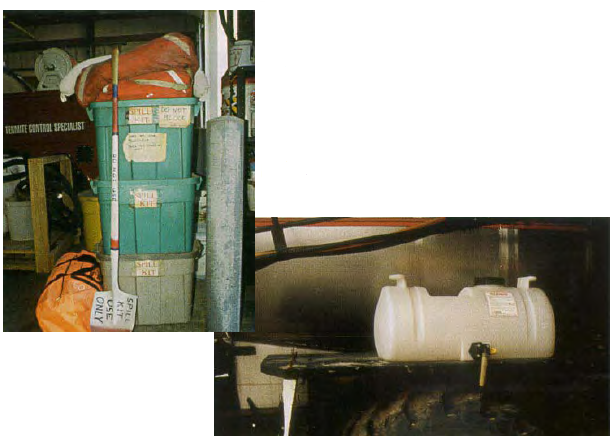
Left: Labeled emergency supplies and shovel.
Right: Clean water tank mounted on application equipment.
Multiple storage sites may complicate emergency communications and cost more to secure. To avoid confusion:
- Have a dedicated location in which to store pesticides. It is easier and cheaper to manage and secure one location than it is multiple locations.
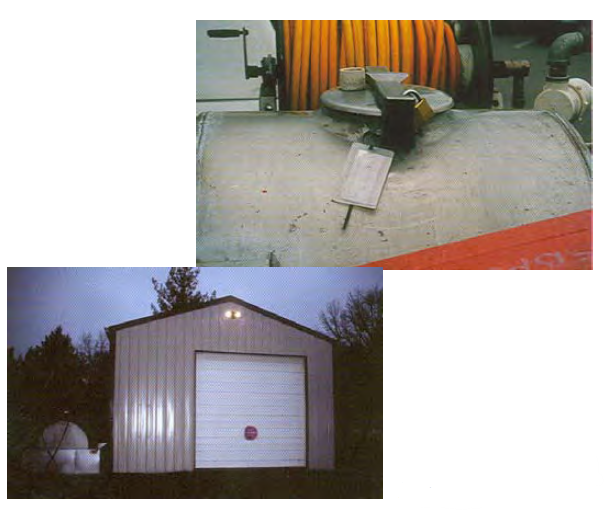
RIght: Tank lid secured with a padlock. Left: Lighted storage facility.
Practicing Professionalism
Pesticide use is an important part in managing pests; however, it includes both benefits and risks. Be a good neighbor and enhance your image with the public by using best management practices and working in a professional manner.
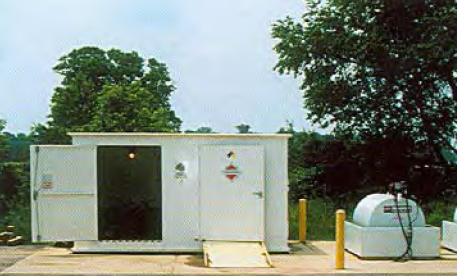
A self-contained pesticide storage building.
Practicing professionalism includes:
- Ensuring employees are properly trained in application and safety procedures, as well as telephone manners and overall customer service.
- Presenting an image of a qualified professional by maintaining appropriate and clean attire, equipment, vehicles and facilities.
- Keeping updated by attending continuing education trainings and association meetings.
Safely handling pesticides is not complicated, time-consuming or expensive. Use common sense and think ahead to reduce potential problems. Examine the way you purchase, mix, store, transport, secure and work with pesticides to determine any potential risks; then implement improvements to reduce these risks. Operate in a professional manner and treat coworkers and customers accordingly. Avoid liability and regulatory problems, protect property values, and reduce costs such as insurance premiums and expenses associated with spills and accidents. NEVER TAKE PESTICIDE SAFETY FOR GRANTED!
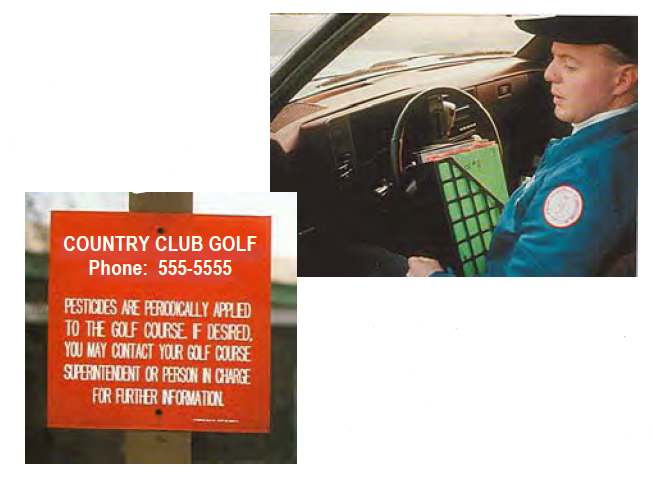
Left: Be a good neighbor. Go beyond what is required by the label or by law.
Right: Present a professional image with proper attire and a clean vehicle. Have information on the pesticides you are using to give customers.
Information herein is offered with no discrimination. Listing a product does not imply endorsement by the authors, University of Nevada Cooperative Extension (UNCE) or its personnel. Likewise criticism of products or equipment not listed is neither implied nor intended. UNCE and its authorized agents do not assume liability for suggested use(s) of chemical or other pest control measures suggested herein. Pesticides must be applied according to the label directions to be lawfully and effectively applied.
Pictures used with permission from Purdue University Cooperative Extension Service, Purdue Pesticide Programs publication PPP-61, “Pesticide Safety Tips for the Workplace and Farm,” 2003, F. Whitford, A. Martin, J. Becovitz and A. Blessing.
Strom, S., Johnson, W., and Whitford, F.
2005,
Pesticide Safety Tips for Private and Commercial Applicators Best - Management Practices,
Extension | University of Nevada, Reno, SP-05-11


